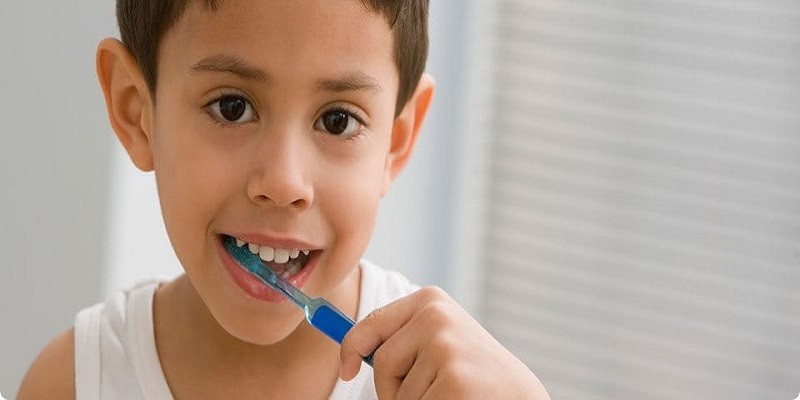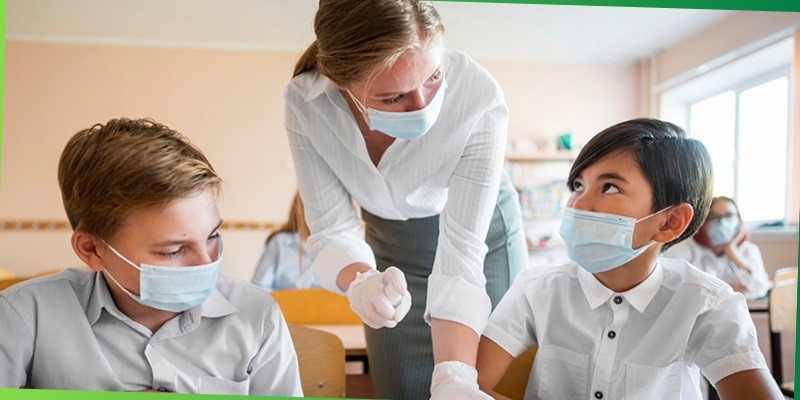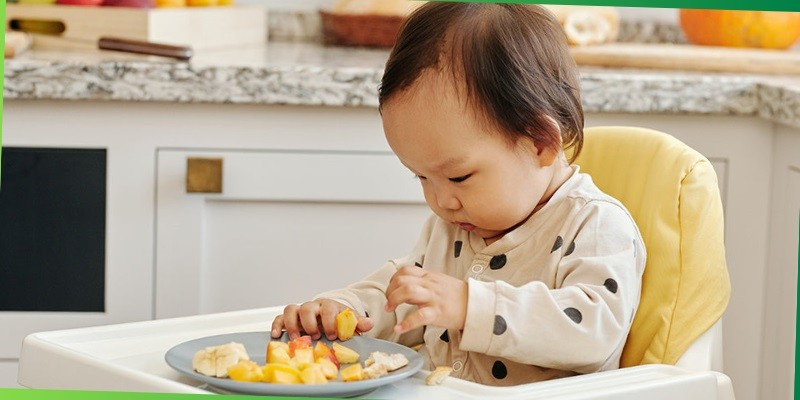Last Updated on January 15, 2025
To naturally whiten a child’s teeth, you can use baking soda and hydrogen peroxide in a gentle and safe manner. It’s important to take appropriate precautions to protect your child’s dental health.
A bright and healthy smile can boost a child’s confidence and self-esteem. However, factors like poor oral hygiene, certain medications, and consuming sugary or acidic foods and beverages can cause teeth stains. While professional dental treatments are available, you can also opt for natural remedies to whiten your child’s teeth.
Using a mixture of baking soda and hydrogen peroxide can effectively remove stains and promote whiter teeth. However, it is essential to ensure that your child brushes gently, avoids excessive use, and follows regular oral hygiene practices to maintain optimal dental health.
The Causes Of Yellow Teeth
When it comes to pediatric dental care, maintaining the appearance of your child’s teeth is just as important as their overall oral health. Yellow teeth can be a cause of concern for parents, as they can affect a child’s self-confidence and social interactions. Understanding the causes of yellow teeth is essential in order to identify the underlying factors and take appropriate action to improve your child’s dental aesthetics. In this article, we will explore the factors that contribute to teeth discoloration in children and provide insights on how to identify the underlying causes of yellow teeth.
Factors That Contribute To Teeth Discoloration In Children
Several factors can lead to teeth discoloration in children. It is important to become aware of these factors to prevent or address yellow teeth effectively. Here are some common contributors:
- Poor Oral Hygiene: Inadequate brushing and flossing can contribute to the buildup of plaque and stains on children’s teeth, leading to discoloration over time.
- Dietary Habits: Consumption of certain foods and beverages, such as sugary snacks, sodas, and artificially colored candies or drinks, can stain teeth and cause them to turn yellow.
- Trauma or Injury: Trauma or injury to a child’s teeth can disrupt tooth development and lead to yellowing or discoloration.
- Genetic Factors: Sometimes, yellow teeth can be hereditary, and certain genetic conditions can lead to tooth discoloration.
- Medications: Certain medications, such as antibiotics like tetracycline, can cause intrinsic discoloration of teeth, especially if taken during tooth development.
How To Identify The Underlying Causes Of Yellow Teeth
Identifying the underlying causes of yellow teeth is crucial for implementing effective treatments. Here are some steps you can take to identify the causes:
- Consult a Pediatric Dentist: Schedule an appointment with a pediatric dentist who specializes in children’s oral health. They can perform a thorough examination, identify potential causes, and recommend appropriate treatment options.
- Review Your Child’s Oral Care Routine: Assess your child’s brushing and flossing habits. Make sure they are brushing their teeth at least twice a day with a fluoridated toothpaste and using proper technique.
- Evaluate Your Child’s Diet: Look closely at your child’s dietary habits. Limit their consumption of sugary and acidic foods and encourage them to eat a balanced diet with plenty of fruits and vegetables.
- Take Note of Medications: If your child is taking any medications, discuss them with the dentist. Certain medications can cause tooth discoloration, and the dentist may provide suitable alternatives or guidance.
- Consider Family History: If yellow teeth run in the family, it is worth discussing this with the dentist. They can evaluate if genetic factors are contributing to the discoloration and suggest appropriate interventions.
By understanding the factors that contribute to yellow teeth and following these steps to identify the underlying causes, you can play an active role in improving your child’s oral health and preserving their beautiful smile.
Maintaining Proper Oral Hygiene
Maintaining proper oral hygiene is crucial for keeping your child’s teeth healthy and white. By establishing a consistent brushing routine, teaching effective flossing techniques, and choosing toothpaste and toothbrushes suitable for kids, you can ensure your child’s teeth stay sparkling white naturally.
Establishing A Consistent Brushing Routine
Establishing a consistent brushing routine is the foundation of good oral hygiene for children. Start by introducing brushing twice a day, morning and night. Encourage your child to brush for at least two minutes, covering all areas of their mouth, including the front, back, and chewing surfaces of their teeth.
Make brushing fun by choosing a toothbrush with colorful designs or their favorite cartoon character. You can also play their favorite song to make the two minutes fly by. Remember to replace their toothbrush every three to four months or sooner if the bristles become frayed.
Flossing Techniques For Children
While brushing is essential, flossing is equally important in maintaining proper oral hygiene. Teach your child proper flossing techniques when their teeth start to touch each other, usually around the age of two or three. Use a child-sized flosser or a piece of floss about 18 inches long.
- Hold the floss tight between your thumb and index finger.
- Gently guide the floss between their teeth using a back-and-forth motion.
- Curve the floss into a C-shape against one tooth and slide it up and down along the tooth’s side.
- Move to the next tooth and repeat the process.
- Don’t forget to floss behind the last teeth at the back of their mouth!
Choosing Toothpaste And Toothbrush Suitable For Kids
Choosing the right toothpaste and toothbrush is essential for your child’s oral health. Look for toothpaste with fluoride, as it helps strengthen the tooth enamel and prevent tooth decay. For children under the age of two, use a smear of toothpaste the size of a grain of rice. For children aged two to five, use a pea-sized amount.
When selecting a toothbrush, opt for a soft-bristled brush with a small head, specifically designed for children. Hard bristles can irritate their sensitive gums and cause discomfort. Encourage your child to brush gently, using small circular motions to clean their teeth and gums thoroughly.
By following these tips and maintaining a consistent oral hygiene routine, you can keep your child’s teeth white naturally and establish good habits that will benefit them for a lifetime. Remember, regular dental check-ups are also important to ensure their dental health remains in top shape.
Diet And Teeth Whitening
When it comes to achieving a brighter smile for your child, diet plays a crucial role. The foods and drinks they consume can have a significant impact on the color and overall health of their teeth. By incorporating teeth-friendly foods and avoiding those that stain, you can naturally help whiten your child’s teeth. In this article, we will explore the foods and drinks that stain teeth, as well as the ones that promote teeth whitening.
Foods And Drinks That Stain Teeth
Some foods and drinks contain pigments that can leave unsightly stains on your child’s teeth. By limiting their consumption or encouraging proper dental hygiene practices after consuming them, you can minimize the staining effect. Here are some examples:
| Staining Foods | Staining Drinks |
|---|---|
| Blueberries | Coffee |
| Pomegranates | Tea |
| Tomato sauce | Red wine |
| Curry | Cola |
To prevent these foods and drinks from leaving stubborn stains on your child’s teeth, encourage them to brush their teeth or rinse their mouth with water after consumption. Promote good dental hygiene habits such as regular brushing and flossing to maintain the natural whiteness of their teeth.
Incorporating Teeth-friendly Foods Into Your Child’s Diet
While some foods have the potential to stain teeth, others can contribute to teeth whitening. By incorporating these teeth-friendly foods into your child’s diet, you can naturally help brighten their smile:
- Crunchy fruits and vegetables like apples and carrots can act as natural toothbrushes, scrubbing away surface stains.
- Dairy products like milk, cheese, and yogurt contain calcium and phosphates that help strengthen tooth enamel, making teeth less susceptible to staining.
- Leafy greens such as spinach and kale are rich in minerals that promote optimal oral health.
- Strawberries contain malic acid, which can naturally whiten teeth. However, make sure to brush your child’s teeth after enjoying strawberries, as their natural sugars can lead to cavities if left on the teeth for too long.
In addition to incorporating these foods into your child’s diet, it is essential to maintain regular dental check-ups and professional teeth cleaning to ensure their teeth stay healthy and white.
Foods That Naturally Help Whiten Teeth
While there are foods that can help prevent staining, some have the added benefit of naturally whitening teeth. These foods contain ingredients that actively promote tooth whitening:
- Baking soda: It acts as a natural teeth cleanser and can effectively remove surface stains.
- Oranges and pineapples: These fruits contain enzymes that help break down plaque and remove surface stains.
- Sesame seeds: Chewing these tiny seeds can help scrub away plaque and stains.
- Apples: Their high water content stimulates saliva production, which helps wash away food particles and stains.
By incorporating these foods into your child’s diet, you can help naturally whiten their teeth while also promoting good oral health.
Natural Remedies For Whitening Teeth
When it comes to keeping your child’s teeth white and bright, natural remedies can be a safe and effective option. These remedies, derived from common household ingredients and practices, are free from harsh chemicals and provide gentle yet noticeable results. Here are some of the most popular natural remedies for whitening teeth:
Baking Soda As A Gentle Whitening Agent
Baking soda, also known as sodium bicarbonate, is a versatile ingredient that can be used for various purposes. When it comes to teeth whitening, baking soda acts as a mild abrasive that helps remove surface stains and restore the natural whiteness of the teeth. Its alkaline nature also helps balance the pH level in the mouth, preventing the growth of bacteria that may cause tooth discoloration.
Activated Charcoal For Removing Surface Stains
Activated charcoal has gained popularity in recent years as a natural teeth whitening remedy. Its porous texture allows it to bind to surface stains, toxins, and bacteria, effectively removing them from the teeth. Activated charcoal may help eliminate coffee, tea, or red wine stains, giving your child’s teeth a brighter and cleaner appearance. However, it’s important to note that activated charcoal should be used sparingly to avoid damaging the tooth enamel.
Lemon And Strawberry As Natural Bleaching Agents
Lemon and strawberry are two fruits that can naturally lighten the color of the teeth. Lemon contains citric acid, which acts as a natural bleaching agent, while strawberry contains malic acid, which helps remove surface stains. However, since these fruits are acidic, it’s crucial to exercise caution when using them. We recommend diluting lemon juice with water or mashing strawberries into a paste and applying them to the teeth for a short period of time. Always rinse thoroughly afterward to prevent prolonged exposure to acid.
Oil Pulling For Oral Health Benefits
Oil pulling is an ancient Ayurvedic practice that involves swishing a tablespoon of oil (such as coconut oil or sesame oil) in the mouth for about 15-20 minutes. This practice not only helps improve oral health by removing harmful bacteria and promoting gum health but also contributes to teeth whitening. The oil effectively binds to plaque and microbes, reducing the yellowish appearance of teeth over time. Incorporating oil pulling into your child’s oral care routine can provide multiple benefits beyond teeth whitening.
By utilizing these natural remedies for teeth whitening, you can maintain your child’s oral health while achieving a brighter smile. Implementing these practices consistently and in moderation can lead to noticeable results over time. Remember to consult with a dentist before trying any new teeth whitening method to ensure it is suitable for your child’s specific dental needs.
Best Practices For Teeth Whitening
When it comes to whitening your child’s teeth, it is essential to follow the best practices to ensure safe and effective results. Moderation and patience are key aspects to consider, along with recommendations for the safest and most effective whitening methods. Moreover, it is crucial to consult with a dentist before trying any treatments. Let’s take a closer look at each of these aspects.
The Importance Of Moderation And Patience
When it comes to teeth whitening, the importance of moderation and patience cannot be emphasized enough. Many parents are eager to see quick results, but it is crucial to understand that teeth whitening is a gradual process. Excessive or frequent whitening treatments can damage the enamel and cause sensitivity in your child’s teeth. Therefore, it is essential to exercise patience and moderation while whitening your child’s teeth.
Recommendations For Safe And Effective Whitening Methods
While there are numerous teeth whitening methods available, not all of them are suitable for children. It is important to choose safe and effective whitening methods that have been specifically designed for young teeth. Here are some recommendations:
- Brushing with Baking Soda: Baking soda is a natural and gentle abrasive that can help remove surface stains from your child’s teeth. Mix a small amount of baking soda with water to form a paste, then brush your child’s teeth with it gently. However, it is important not to overdo it, as excessive use of baking soda can potentially erode the tooth enamel.
- Fruits and Vegetables: Encourage your child to consume fruits and vegetables that have a natural whitening effect on teeth. Crunchy fruits like apples and strawberries can help remove stains due to their cleansing properties.
- Oil Pulling: This ancient Ayurvedic method involves swishing oil (such as coconut or sesame oil) in the mouth to remove bacteria and stains. However, it is important to note that oil pulling should be done under adult supervision, and it may take some time to see results.
- Professional Dental Whitening: If your child’s teeth require advanced whitening, it is best to consult with a dentist who can provide professional whitening options suitable for young teeth. They can ensure safe and effective results while taking into consideration your child’s dental health.
Discussing With A Dentist Before Trying Any Treatments
Prior to starting any teeth whitening treatments for your child, it is crucial to discuss the matter with a dentist. They will evaluate your child’s dental health, recommend specific treatments, and provide guidance based on their professional expertise. Consulting with a dentist ensures that your child’s teeth are in the best hands and minimizes any risks associated with improper whitening methods.
In-office Teeth Whitening Options
When it comes to teeth whitening for children, in-office dental treatments offer a professional and effective solution. Professional dental treatments are administered by trained dentists who use safe and reliable methods to ensure the desired results. In this section, we will explore the various professional teeth whitening procedures available for children, the pros and cons associated with them, as well as precautions to consider for pediatric dental treatments.
Professional Dental Treatments For Children
There are several in-office teeth whitening options suitable for children. These treatments are specifically designed to be gentle yet effective, taking into consideration the sensitivity of a child’s teeth. Here are some common professional dental treatments available:
- Laser teeth whitening: This procedure involves using a laser or light source to activate a whitening agent applied to the teeth. It is a quick and efficient method that provides noticeable results in just one session.
- Custom teeth whitening trays: Dentists can create custom-made trays that perfectly fit a child’s teeth. These trays are filled with a professional-grade whitening gel and worn for a specific amount of time to achieve the desired level of whiteness.
- In-office bleaching: Dentists may utilize strong whitening agents that are carefully applied to the teeth during an in-office bleaching procedure. This procedure usually requires multiple sessions to achieve the desired results.
Pros And Cons Of Professional Teeth Whitening Procedures
Like any dental treatment, professional teeth whitening procedures have their pros and cons. Understanding these can help parents make an informed decision for their child’s oral health. Let’s take a look at the advantages and disadvantages:
| Pros | Cons |
|---|---|
|
|
Precautions To Consider For Pediatric Dental Treatments
While professional teeth whitening procedures can be effective, it is important to consider precautions specific to pediatric dental treatments. Here are some key factors to keep in mind:
- Consultation with a pediatric dentist: Before proceeding with any dental treatment, it is crucial to consult a pediatric dentist who can assess the child’s oral health and determine the suitability of teeth whitening.
- Patient age and maturity: The dentist will consider the child’s age and maturity level to determine if they are ready for a teeth whitening treatment.
- Potential risks and side effects: Parents should be aware of the potential risks and side effects associated with teeth whitening, such as tooth sensitivity or gum irritation.
- Follow-up care: It is essential to follow the dentist’s instructions regarding aftercare, including proper oral hygiene routines and any recommended maintenance treatments.
With these precautions in mind, professional teeth whitening options can be a safe and effective way to whiten a child’s teeth. Consulting with a pediatric dentist will ensure the best course of action for achieving a brighter and healthier smile for your child.
Maintaining Long-term Teeth Whitening Results
Once you have successfully whitened your child’s teeth naturally, it is important to maintain long-term results to preserve their pearly whites. Consistency is key when it comes to dental hygiene, and there are several steps you can take to prevent future teeth discoloration and keep your child’s smile bright and radiant.
Tips To Prevent Future Teeth Discoloration
- Encourage your child to develop healthy eating habits, avoiding excessive consumption of sugary foods and beverages that can stain teeth.
- Ensure your child maintains good oral hygiene by brushing their teeth at least twice a day for two minutes each time. Make sure they use a fluoride toothpaste to strengthen their enamel.
- Teach your child the proper technique for brushing their teeth, including brushing in circular motions and reaching all surfaces of their teeth.
- Emphasize the importance of flossing daily to remove plaque and prevent stains from forming in between teeth.
- Consider using a straw when your child drinks beverages that can potentially stain their teeth, such as tea or fruit juice. This will help minimize contact between the liquid and their teeth.
- Encourage your child to rinse their mouth with water after consuming foods or drinks that may stain their teeth.
Regular Dental Visits For Professional Cleaning
Regular dental visits are essential for maintaining long-term teeth whitening results. During these visits, a dental professional can remove any plaque or tartar buildup that may lead to discoloration. They can also provide a professional cleaning to polish the teeth, resulting in a brighter smile. Ensure your child visits the dentist every six months for a thorough examination and cleaning.
Reinforcing Good Oral Hygiene Habits For Your Child
As a parent, it is crucial to reinforce good oral hygiene habits for your child to maintain their teeth whitening results. Establish a routine for brushing and flossing, and make it a fun and enjoyable activity. Show them the proper techniques and supervise their brushing until they can do it independently. Additionally, consider using a timer or a musical toothbrush to make it more engaging. By instilling these habits early on, you are setting your child up for a lifetime of good oral health.

Credit: www.medicalnewstoday.com
Frequently Asked Questions On How To Whiten Child’s Teeth Naturally?
How Can I Naturally Whiten My Child’s Teeth At Home?
To naturally whiten your child’s teeth at home, you can encourage regular brushing with baking soda or using a banana peel to gently rub their teeth.
Conclusion
To sum up, keeping your child’s teeth naturally white is achievable with a few simple remedies. Emphasize regular oral hygiene practices such as brush twice a day, limit sugary foods, and encourage a balanced diet. Natural remedies like baking soda and hydrogen peroxide can be helpful in maintaining their pearly whites.
Remember, consulting a dentist for professional advice is essential for long-term oral health. With consistent care, your child can have a healthy and radiant smile that lasts a lifetime.







